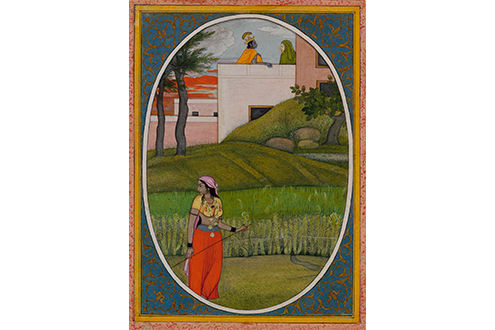
Exhibition Dates: June 14–September 12, 2016
Exhibition Location: The Met Fifth Avenue, Floor 2, The Charles Z. Offin Gallery,
Karen B. Cohen Gallery, Harriette and Noel Levine Gallery, Galleries 691–693
Compelling episodes from the epic and poetic literature of the Indian subcontinent dominate the nearly 100 masterful paintings—most a 2015 promised gift by Steven M. Kossak from his family’s Kronos Collections—on display at The Metropolitan Museum of Art. Created mainly between the 16th and the early 19th century for the royal courts of Rajasthan and the Punjab Hills in northern India, the works on view in the exhibition Divine Pleasures: Painting from India’s Rajput Courts—The Kronos Collections which opened June 14, are meant to move the soul and delight the eye. Suffused with the powerful imagery of the myths of the past, Indian painting expressed a new way of seeking the divine through bhakti, or personal devotion. The collection was assembled over nearly four decades by Mr. Kossak, formerly a curator in The Met’s Department of Asian Art.
“We are delighted to present this exhibition of Steve Kossak’s generous promised gift,” said Thomas P. Campbell, Director and CEO of The Met. “These distinguished paintings constitute one of the premier collections of this material in private hands, and their eventual addition to The Met collection will transform the Museum’s holdings of Rajput painting. It is a significant addition to Steve’s legacy at The Met after serving for two decades as a curator.”
Exhibition Overview
The exhibition is organized into three major sections—Early Rajput and Rajasthan, early Pahari (Punjab Hills), and later Pahari. Within each room, the paintings will be shown in relation to the literary traditions of Indian Hinduism. Rajput court painting was mainly intended for royal delectation, to amplify through the artistic fantasy manifest in the pictures, well-known religious, quasi-religious, and secular texts and subjects. The power and magic of the images transcends the subjects they portray.
Under the patronage of their Rajput rulers, many of the principalities of north India developed and nurtured a distinctive painting style. This galaxy of stylistic expression is amply demonstrated in the exhibition through compelling examples of the Early Rajput Style; the later schools of Bikaner, Bundi, Kishangarh, Kota, and Mewar; as well as many of the small courts of the Punjab Hills: Bahu, Bahsoli, Bislalpur, Chamba, Guler, Kangra, Mandi, Mankot, and Nurpur.
Painted on paper in opaque watercolor and ink, they are often heightened with gold and silver. Whites are often raised to simulate pearls and reflective beetle-wing casings stand in for emeralds. Many of the paintings have never before been exhibited publicly.
The exhibition was organized by Navina Haidar, Curator, and Courtney Stewart, Senior Research Assistant, of The Met’s Department of Islamic Art. Exhibition design is by Daniel Kershaw, Exhibition Design Manager; graphics are by Constance Norkin, Graphic Design Manager; and lighting is by Clint Ross Coller and Richard Lichte, Lighting Design Managers, all of the Museum’s Design Department.
Related Publication and Programs
The exhibition is accompanied by a publication written by Terence McInerney, with contributions by Mr. Kossak and Ms. Haidar. Published by The Metropolitan Museum of Art and distributed by Yale University Press, it will be available in The Met Store.
The catalogue is made possible by The Peter Jay Sharp Foundation.
Education programs include a series of exhibition tours and a MetFridays program on July 22 that will focus on the power of objects, large and small.
The exhibition is featured on The Met website, as well as on Facebook, Instagram, and Twitter via the hashtag #DivinePleasures.
Related Installation
Concurrent with the exhibition is a small, thematically related display, Poetry and Devotion in Indian Painting: Two Decades of Collecting (June 15–December 4, 2016) in the Florence and Herbert Irving Galleries for the Arts of South and Southeast Asia, Indian Painting Gallery, Gallery #251. Recognizing the contributions of Mr. Kossak to the Department of Asian Art, where he was a curator from 1986 to 2006, it features 22 of the dozens of Rajput and Pahari paintings that were acquired during his tenure, including a large intricately painted and printed cloth pichwai (temple hanging).
The exhibition is made possible by The Miriam and Ira D. Wallach Foundation Fund.
The exhibition will be featured on The Met website, as well as on Facebook, Instagram, and Twitter via the hashtag #DivinePleasures.
# # #
Updated August 1, 2016
Image: The Village Beauty. Probably painted by the artist Fattu (active ca. 1770-1820). Illustrated folio from the dispersed "Kangra Bihari" Sat Sai (Seven Hundred Verses). Punjab Hills, kingdom of Kangra, ca. 1785. Opaque watercolor, ink, and gold on paper; narrow yellow and white borders with black inner rules; dark blue spandrels decorated with gold arabesque; painting 7 3/8 x 5 3/16 in. (18.7 x 13.2 cm), page 8 1/8 x 5 7/8 in. (20.6 x 14.9 cm). Promised Gift of the Kronos Collections, 2015 (SK.082)
Press resources